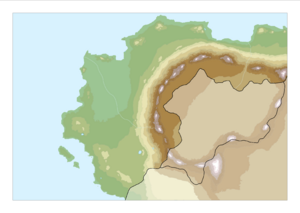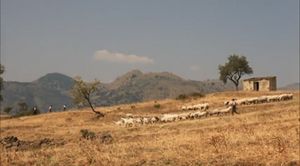Difference between revisions of "Salisford"
m |
(History) |
||
| Line 71: | Line 71: | ||
== Old Savottan Monarchy == | == Old Savottan Monarchy == | ||
| − | + | The city of Savotta grew tremendously, with trade coming from upriver and port activity from the coast. Archeological evidence suggests that the area was under the influence of the Terraltans, who settled the neighboring Highlands. However, this political influence seems to have vanished in the 6th century BC. | |
| + | |||
| + | Historical tradition holds that the seat of power of the Savottan King was within the Savottan Forum. However, legal protections of the historical Savottan Forum site have prevented archeological investigation. | ||
== Savottan Republic == | == Savottan Republic == | ||
| − | + | According to tradition and Savottan tradition, there were 10 Kings of Savotta. The last of whom, King Titius the Cruel, was deposed in 518 BC by Tiberius Vedius Major. In place of the monarchy, a republic was established that operated on elected magistrates and multiple representative assemblies. The most prominent magistrate was the Dux, who was elected for a 3-year period. The Dux was overseen by three Auxili, who were responsible for ensuring the Dux did not surpass his constitutional powers. All major magistrates were granted the power to command armies. Other magistrates include tribunes, auditors, iudices, ludari, and exactores. | |
| + | The Savottans gradually subjugated the tribes surrounding the city and grew into the interior plain of Salisford, as well as into the western highlands. | ||
== Fall of the Republic & the Principate == | == Fall of the Republic & the Principate == | ||
| − | + | Over time, the Republic grew to be corrupt. Two political factions arose, a populist and an aristocratic faction. A Savottan magistrate overthrew the government and threw out all of the populist magistrates. While this was happening, the wealth gap between the aristocracy and the impoverished lower classes grew more and more. The Savottan magistrate’s reign was short-lived, however, he was banished by the government and the Republic was re-established. The populists supported an anti-government conspiracy that was quickly defused by a prominent conservative Dux. | |
| + | |||
| + | Into this scene appeared Flavius Oppius Major, a descendant of Vedius Major. Oppius Major made a name for himself as an accomplished general, defeating many tribes on the northeast frontier of Salisford. Which provided many spoils and many new territories to the Savottan state. Capitalizing on his military fame, he was able to be elected Dux. However, during his term he was prevented from effecting any meaningful reform by the aristocratic faction. At one point he seized one of his Auxili, which was technically an illegal action as the Auxili were considered sacrosanct. But, because of a quirk in the Savottan legal code, Oppius Major was able to escape prosecution by the angered aristocrats by resuming his command on the northeast frontier. | ||
| + | Oppius Major was ultimately able to conquer and pacify the northeast frontier, and, in the process, obtain massive amounts of wealth, respect, and battle-hardened armies who were loyal to him. After an extended political fight with the aristocrats, who tried to deprive Major of his rank and banish him from Savotta, Major invaded the city in 23 BC with his army and was declared Imperator of Savotta. | ||
| + | This would establish the Principate, where Major and his descendants would rule a semi-monarchical and semi-republican state. Where the Imperator’s decrees and decisions would only be effected if supported by the people. | ||
| + | |||
| + | This would go on until 82 AD, where Imperator Tiberius Major would begin reforming the Principate into a more autocratic system. | ||
== Christianization == | == Christianization == | ||
Revision as of 18:37, 25 November 2020
Kingdom of Salisford Salforto | |
|---|---|
Motto: "Per Dio, Re, e Famiglia"
" Jackian: "For God, Family, and King" | |
 | |
| Capital and largest city | Savotta |
| Official languages | Salisfordian |
| Ethnic groups |
|
| Religion | Salforti Catholic (official and dominant) |
| Demonym(s) | Salisfordian |
| Government | Devolved Hereditary Monarchy
|
• Monarch | Francesco II |
| Carlo Valenza | |
| History | |
| 721 BC | |
| 518 BC | |
| 23 BC | |
| 546 AD | |
| 1782 AD | |
| 1790 AD | |
| 1794 AD | |
| 1800 AD | |
| Population | |
• 2019 estimate | 74.2 million |
| GDP (nominal) | 2019 estimate |
• Total | ₡3.571 Trillion QSC (12th) |
• Per capita | ₡48,138 QSC (7th) |
| Gini (2019) | medium |
| HDI (2019) | very high |
| Currency | Salisfordian Lira (SFL) |
| Time zone | AMT-5, -6 |
| Driving side | right |
| Calling code | +8 |
| Internet TLD | .sf |
Salisford, officially the Kingdom of Salisford (Salisfordian: Salforto) is a Medium sized nation on the Southern landmass of Terraconserva. It is bordered to the south by Creeperopolis and El Salvador, to the east by El Salvador and unclaimed territory, and to the north and west by ocean. Salisford's capital city is Savotta. Salisford is a member nation of the Terraconserva Council of Nations.
Contents
History
Ancient Salisford
Paleolithic-era artifacts have been recovered from the Salisfordian Mountain Range, making them the oldest evidence of hominid habitation in the region. Other artifacts found have shown there was a Neanderthal presence in the region as well. The earliest evidence of modern human habitation in Salisford was discovered in the Western Highlands, in the Northern Peak.
Old Savottan Monarchy
The city of Savotta grew tremendously, with trade coming from upriver and port activity from the coast. Archeological evidence suggests that the area was under the influence of the Terraltans, who settled the neighboring Highlands. However, this political influence seems to have vanished in the 6th century BC.
Historical tradition holds that the seat of power of the Savottan King was within the Savottan Forum. However, legal protections of the historical Savottan Forum site have prevented archeological investigation.
Savottan Republic
According to tradition and Savottan tradition, there were 10 Kings of Savotta. The last of whom, King Titius the Cruel, was deposed in 518 BC by Tiberius Vedius Major. In place of the monarchy, a republic was established that operated on elected magistrates and multiple representative assemblies. The most prominent magistrate was the Dux, who was elected for a 3-year period. The Dux was overseen by three Auxili, who were responsible for ensuring the Dux did not surpass his constitutional powers. All major magistrates were granted the power to command armies. Other magistrates include tribunes, auditors, iudices, ludari, and exactores. The Savottans gradually subjugated the tribes surrounding the city and grew into the interior plain of Salisford, as well as into the western highlands.
Fall of the Republic & the Principate
Over time, the Republic grew to be corrupt. Two political factions arose, a populist and an aristocratic faction. A Savottan magistrate overthrew the government and threw out all of the populist magistrates. While this was happening, the wealth gap between the aristocracy and the impoverished lower classes grew more and more. The Savottan magistrate’s reign was short-lived, however, he was banished by the government and the Republic was re-established. The populists supported an anti-government conspiracy that was quickly defused by a prominent conservative Dux.
Into this scene appeared Flavius Oppius Major, a descendant of Vedius Major. Oppius Major made a name for himself as an accomplished general, defeating many tribes on the northeast frontier of Salisford. Which provided many spoils and many new territories to the Savottan state. Capitalizing on his military fame, he was able to be elected Dux. However, during his term he was prevented from effecting any meaningful reform by the aristocratic faction. At one point he seized one of his Auxili, which was technically an illegal action as the Auxili were considered sacrosanct. But, because of a quirk in the Savottan legal code, Oppius Major was able to escape prosecution by the angered aristocrats by resuming his command on the northeast frontier. Oppius Major was ultimately able to conquer and pacify the northeast frontier, and, in the process, obtain massive amounts of wealth, respect, and battle-hardened armies who were loyal to him. After an extended political fight with the aristocrats, who tried to deprive Major of his rank and banish him from Savotta, Major invaded the city in 23 BC with his army and was declared Imperator of Savotta. This would establish the Principate, where Major and his descendants would rule a semi-monarchical and semi-republican state. Where the Imperator’s decrees and decisions would only be effected if supported by the people.
This would go on until 82 AD, where Imperator Tiberius Major would begin reforming the Principate into a more autocratic system.
Christianization
(WORK IN PROGRESS)
The Old Kingdom
(WORK IN PROGRESS)
Salisfordian Revolution
(WORK IN PROGRESS)
Salisfordian Republic
(WORK IN PROGRESS)
Salisfordian Counter-Revolution
(WORK IN PROGRESS)
Salisfordian Monarchy
(WORK IN PROGRESS)
Modern Era
(WORK IN PROGRESS)
Government
Overview
Salisford is a monarchy, headed by a autocratic monarch who rules through decree. Despite the monarch's absolute authority, he has little power. Relying on a bureaucracy of local lords, administrators, and vassal relationships to effect his decrees. The monarchy itself is dedicated to the idea of subsidiarity, with most problems being dealt with on the local level, only moving to higher powers when local powers are unable to deal with the problem effectively.
The Monarchy
(WORK IN PROGRESS)
Geography
Salisford is divided into a number of provinces which are governed by a royally-apointed governor. The coast of Salisford is rocky with high cliffs, however, parts of the coast are lower in elevation and have sandy picture-esque beaches. The interior of Salisford is flat and temperate. The majority of Salisford's population lives in the central plain, however, there are large population centers on the Western Highlands.
Economy
The Salisfordian economy is industrialized and strong economic bases in the fields of manufacturing, engineering, and tourism. However, a large part of the Salisfordian economy is also based in agriculture. Notable Salisfordian corporations include the Royal Salisfordian Arsenal, Beretta, and Piaggio Aerospace.
Salisford's agricultural base is centered around smaller family farms, which have been distributed by royal decree from large estates previously owned by the landed aristocracy.
Salisford is a major exporter of grains, fruits, and vegetables. Most notably: wheat, barley, olives, tomatoes, and garlic.
Military

The Salisfordian military is made up of a core base of volunteers, who make up specialist detachments, the officer corps, and a small standing force. This volunteer force is supplemented by conscripts. Salisfordian males are conscripted into government service after graduation from secondary school. This can be in a civilian service corps for a period of 4 years, or in military service for a period of 2 years.
Salisfordian Air Force
Due to the highly technical nature of the Salisfordian Air Force, the majority of the branch is formed of volunteer career soldiers, and conscripts are only taken in for non-technical jobs, such as Security Forces, Administratives Officers, etc.
Salisfordian Pilot Training is restricted to volunteers.[1]
Demographics
Salisford is made up of a majority of Salisfordians. Due to strict citizenship laws, there is a limited amount of non-Salisfordians who are Salisfordian citizens. However, there is a somewhat-sizable number of non-citizen residents who work and live in Salisford.
See Also
Other Nations
- Creeperopolis
- El Salvador
- Eminople
- Greater Sacramento
- Groffenord
- Lyoa
- Malgax
- Morova
- New Gandor
- Paleocacher
- Quebecshire
- Rakeo
- Reia
- Second State of the Church
- Sequoyah
- Terranihil
- Willdavie
- Xusma
References
- ↑ Abdilla, Sharifullah (March 14, 2014). Taħriġ tal-Bdoti Militari. Royal Salisfordian Air Force Standards and Evaluation Department.





